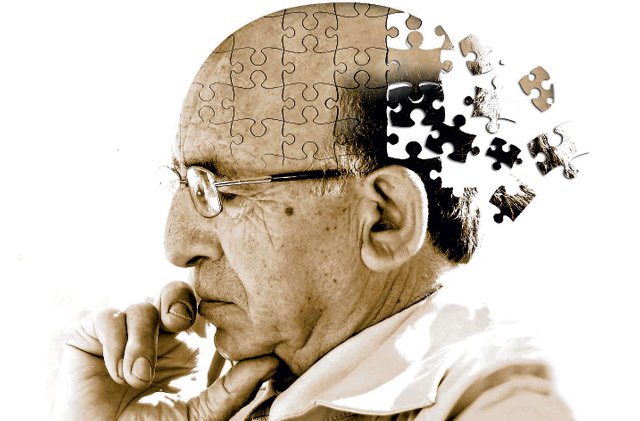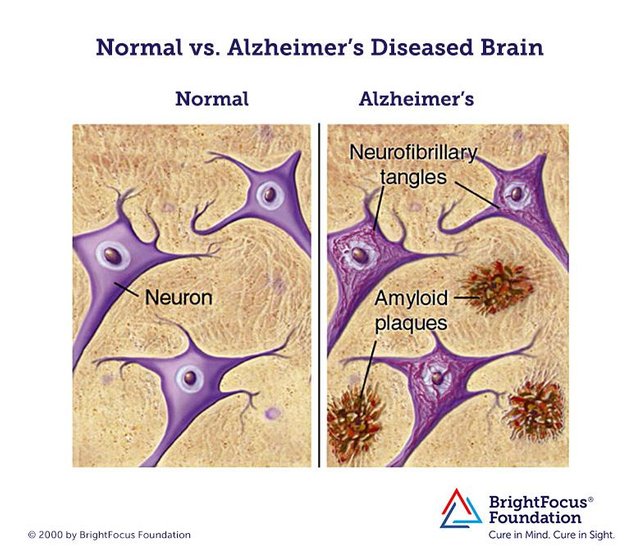What is Alzheimer disease?
I read a news today about Alzheimer disease, I was going to write about it but then I realized that some people may not really know what Alzheimer is. That's why I decided to write this post. You surely have heard of Alzheimer before because it's one of the most common cause of dementia (it accounts for 60 to 80% of dementia cases). In Alzheimer's case there are usually problems with memory, thinking and behavior. The symptoms usually develop slowly but worsen over time.

Time-course
In the early stages, Alzheimer causes only mild memory loss but over time it can get so bad that individuals affected by this disease can lose the ability to carry out conversations and to be responsive of their environment. Initial symptoms can be slowed thinking and occasional problems with remembering things, especially newly learned information. That's because Alzheimer often begins in the region of the brain involved in learning. As the disease progresses to other areas of the brain the symptoms will also become more severe, for example: disorientation mood and behavior changes; deepening confusion about events, time and place; unfounded suspicions about family, friends and professional caregivers; more serious memory loss and behavior changes; and difficulty speaking, swallowing and walking. Generally, after the symptoms become noticeable to others, individuals with Alzheimer live on average 8 years (survival ranges from 4 to 20 years). Alzheimer is the sixth leading cause of death in the United States.
The 10 warning signs:
- Memory loss that disrupts daily life
- Challenges in planning or solving problems
- Difficulty completing familiar tasts
- Confusion with time or place
- Trouble understanding visual images and spatial relationships
- Problems with words in speaking or writing
- Misplacing things and losing the ability to retrace steps
- Decreased or poor judgment
- Withdrawal from work and social activities
- Changes in mood and personality
What exactly happens in the brain in Alzheimer?
We have billions of nerve cells in our brains. Nerve cells are able to communicate with one another by generating electrical signals and transferring them to other cells in form of chemical neurotransmitters. To be more effective, nerves are generally in the same network with other neurons that fulfill related functions. Thus, do their work, brain cells operate like tiny factories. They receive supplies, generate energy, construct equipment and get rid of waste. Cells also process and store information and communicate with other cells. Keeping everything running requires coordination as well as large amounts of fuel and oxygen.
Here you can see how the breaking down in one area can lead to a cascade of problems and cause widespread issues. Generally, in the brain of individual with Alzheimer disease there two main abnormal structures:
- Plaques: these are fragments of a protein (called Beta-amyloid) that over time build up in the spaces between nerve cells affecting communication between them.
- Tangles: There are also intracellular buildups, in this case there is a protein called Tau that tends to accumulate inside nerve cells, affecting their functionality.
Individuals with Alzheimer tend to develop plaques and tangles in predictable patterns, affecting first regions of the brain important for memory before spreading to other areas.

Since we mentioned dementia, here there are other types:
- Vascular dementia is a decline in thinking skills caused by conditions that block or reduce blood flow to the brain, depriving brain cells of vital oxygen and nutrients. These changes sometimes occur suddenly following strokes that block major brain blood vessels. It is widely considered the second most common cause of dementia after Alzheimer’s disease.
- Mixed dementia is a condition in which abnormalities characteristic of more than one type of dementia occur simultaneously. Symptoms may vary, depending on the types of brain changes involved and the brain regions affected, and may be similar to or even indistinguishable from those of Alzheimer’s or another dementia.
- Parkinson’s disease dementia is an impairment in thinking and reasoning that many people with Parkinson’s disease eventually develop. As brain changes gradually spread, they often begin to affect mental functions, including memory and the ability to pay attention, make sound judgments and plan the steps needed to complete a task.
- Dementia with Lewy bodies is a type of progressive dementia that leads to a decline in thinking, reasoning and independent function due to abnormal microscopic deposits that damage brain cells.
- Huntington’s disease dementia is a progressive brain disorder caused by a defective gene. It causes changes in the central area of the brain, which affect movement, mood and thinking skills.
- Creutzfeldt-Jakob disease is the most common human form of a group of rare, fatal brain disorders known as prion diseases. Misfolded prion protein destroys brain cells, resulting in damage that leads to rapid decline in thinking and reasoning as well as involuntary muscle movements, confusion, difficulty walking and mood changes.
- Frontotemporal dementia (FTD) is a group of disorders caused by progressive cell degeneration in the brain’s frontal lobes (the areas behind the forehead) or its temporal lobes (the regions behind the ears).
- Normal pressure hydrocephalus is a brain disorder in which excess cerebrospinal fluid accumulates in the brain’s ventricles, causing thinking and reasoning problems, difficulty walking and loss of bladder control.
- Down syndrome dementia develops in people born with extra genetic material from chromosome 21, one of the 23 human chromosomes. As individuals with Down syndrome age, they have a greatly increased risk of developing a type of dementia that’s either the same as or very similar to Alzheimer’s disease.
- Korsakoff syndrome is a chronic memory disorder caused by severe deficiency of thiamine (vitamin B-1). It is most commonly caused by alcohol misuse, but certain other conditions can also cause the syndrome.
- Posterior cortical atrophy (PCA) is the gradual and progressive degeneration of the outer layer of the brain (the cortex) located in the back of the head (posterior). It is not known whether PCA is a unique disease or a possible variant form of Alzheimer’s disease.
Treatments
Today much focus is directed at understanding what causes Alzheimer but despite notable progress we still don't have a universal cure. The good news is that new potential strategies are currently under investigation but as of yet the only treatments available target mainly symptoms of this disease.
For more information and the latest news on Alzheimer you can check out the following blog:
img credz: pixabay.com
Nice, you got a 96.0% @glitterbooster upgoat, thanks to @aboutcoolscience
Want a boost? Minnowbooster's got your back!
The @OriginalWorks BETA V2 bot has upvoted(0.5%) and checked this post!
Some similarity seems to be present here:
https://alz.org/national/documents/brochure_basicsofalz_low.pdf
This is an early BETA version. If you cited this source, then ignore this message! Reply if you feel this is an error.
As @ultimatum said, well written and very informative, but I would add that it makes me very sad. I've known a couple people with dementia and I'm very glad of how much effort is going into research of Alzheimer's.
Well written and very informative.
Nicely done.
A detail post about Alzheimer disease. Actually It was first detected in 1901. But people didn't have much knowledge about it till end of 20th Century. There are some famous people or world leaders who suffered from Alzheimer's, notably President Ronald Reagan, Robin Williams, Malcolm Young, Pat Summitt,Charlton Heston etc source
thanks